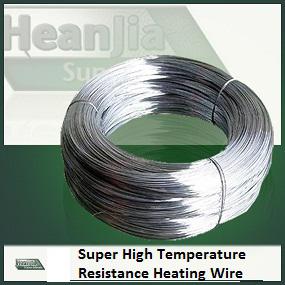

The Resistance Wire is primarily a nichrome reistance wire that comprises of significant electric resistance. Its resistance increases gradually with an increase in temperature due to its high temperature coefficient of resistance. It is widely utilized in the production of strong electric resistors and heating appliances that produce large heat at the high temperatures.
The resistance wire is a tough and dense alloy that causes excellent resistant to oxidation and other corrosions at the elevated temperatures. It produces security layer when heated extensively. It offers large service temperature limit and extended performance life with high stress competency. It has high tensile strength and shows non magnetic nature.
Wire Specification
|
Wire Diameter |
0.05mm to 10.0 mm |
Physical Properties of Resistance Wire:
|
Grade |
Cr20Ni80 |
Cr30Ni70 |
Cr15Ni60 |
Cr20Ni35 |
Cr20Ni30 |
|
|
Major chemical composition % |
Ni |
Balance |
Balance |
55.061.0 |
34.037.0 |
30.034.0 |
|
Cr |
20.023.0 |
28.031.0 |
15.018.0 |
18.021.0 |
18.021.0 |
|
|
Fe |
=1.0 |
=1.0 |
Balance |
Balance |
Balance |
|
|
Components maximum use temperature |
1200 |
1250 |
1150 |
1100 |
1100 |
|
|
Melting point |
1400 |
1380 |
1390 |
1390 |
1390 |
|
|
Density g/cm3 |
8.40 |
8.10 |
8.20 |
7.90 |
7.90 |
|
|
Resistivity,20 |
1.09-0.05 |
1.18-0.05 |
1.11-0.05 |
1.04-0.05 |
1.04-0.05 |
|
|
Extension rate% |
=20 |
=20 |
=20 |
=20 |
=20 |
|
|
Specific heat J/g. |
0.440 |
0.461 |
0.494 |
0.500 |
0.500 |
|
|
Heat conduction coefficient KJ/m.h |
60.3 |
45.2 |
45.2 |
43.8 |
43.8 |
|
|
Linear expansion coefficient |
18.0 |
17.0 |
17.0 |
19.0 |
19.0 |
|
Applications of Resistance Wire
1.Electric oven and toaster
2. Strong resistor
3. Electric heater and furnaces
4. Wires, lead wire in lamps, electronic tubes
More details:View company website
Its Free
Verify Now